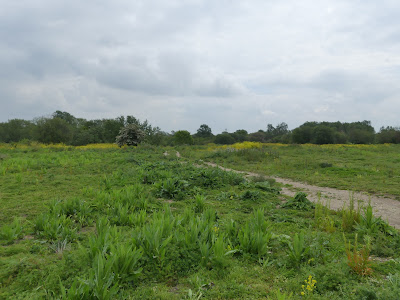The main objective today was to check the two nest boxes and ring any pulli of a suitable size. Before making our checks, we put up four nets so that we might retrap a few birds of our residents and even perhaps the odd summer migrant.
We were disappointed to find that our notices had all been torn down and left on the ground. Our immediate thought was that this happened when maintenance and new signs were put up by the fishing club. Anyway, in spite of this and a pile of fly-tipped waste (initially it just looked like cut vegetation, but a string of defunct LED lights gave it away), we continued and got our four nets up.
We then moved on to look at the two nest boxes, thankfully they were still there. Box one had been used by Great Tits. We know this as one recently dead, well grown chick was left in the box. At least we knew the box had been used and some young had fledged successfully. Box two had been claimed by a pair of very tenacious Blue Tits. They chided us and stayed very close by in the time it took for us to remove the brood of eight and ring each one before posting them back into the box. They are our first, successfully ringed young at Broadwater and we decided to identify suitable sites and put up a few more boxes, for Robin and tits. By the end of the morning we were seriously rethinking that idea.
The nets gave us some new Blackcaps (no returning ringed birds unfortunately) and retraps of Great Tit, Blue Tit and Dunnock. There was also a new Song Thrush and juvenile Robin and Long-tailed Tit.
Juvenile Robin
Chris wandered away from our ringing area, recording Mute Swan 4AJE on the lake and two other swans, as yet unringed. He also spoke to a fisherman who said that there is a plan to extract gravel from the immediate area for HS2. There had been inspections to see whether the causeway was suitable for HGV movements. It is fairly clear that it is not and it seems there is little chance that our ringing area will be untouched if this plan goes ahead. From what was said, it seems that the whole area is likely to be bulldozed to put in infrastructure for gravel extraction and heavy goods movements. As we were leaving, it struck us that the reason there had been so much cutting back of trees between the access track and canal is to widen the road to permit two way movement of HGVs. In the event the company are starting work this year, we may still have the site until early September, if they observe the breeding season, broadly February to August, since it is an offence to intentionally or recklessly cut down a tree with birds nesting. However, what are the chances that big business will have any consideration for wildlife? HS 2 effects are not just confined to tbe immediate route!
It is an offence to cut down a hedge or tree intentionally or recklessly whilst there are birds nesting in it.
Reckless is a term often used in legal definitions. In this context it means that if you cut the tree down and you knew there was a chance that birds were nesting there and you didn't check, and there were birds nesting there, then you would have been reckless and, therefore, guilty of the offence.
The penalties are imprisonment and/or a fine. If there is more than one bird, nest or egg then there will be a separate fine for each one.
All being ignored as HS2 work goes ahead - the law is meaningless to big business. But, then should only multi-million pound projects be forced to work outside the breeding season creating a higher cost for us all. One area that could be debated until the cows come home, and probably for a lot of people irrelevant.......probably the risk their Huawei phone will not get some updates is more of a concern?
Totals: 14 (4)
Dunnock - 0 (1)
Robin - 1
Song Thrush - 1
Blackcap - 3
Long-tailed Tit - 1
Blue Tit - 0 (1) & 8 pulli
Great Tit - 0 (2)


















































